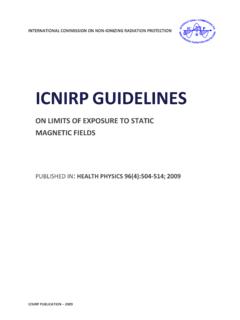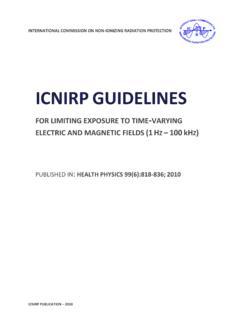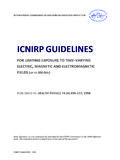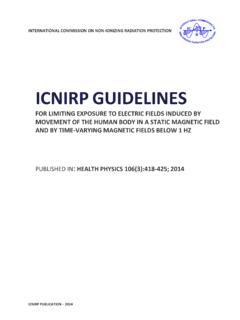Transcription of ICNIRP GUIDELINES
1 INTERNATIONAL COMMISSION ON NON-IONIZING RADIATION PROTECTION ICNIRP PUBLICATION 2020 ICNIRP GUIDELINES FOR LIMITING EXPOSURE TO ELECTROMAGNETIC FIELDS ( 100 khz TO 300 GHZ) PUBLISHED IN: HEALTH PHYS 118(5): 483 524; 2020 PUBLISHED AHEAD OF PRINT IN MARCH 2020: HEALTH PHYS 118(00):000 000; 2020 Special SubmissionGUIDELINES FOR LIMITING EXPOSURE TO ELECTROMAGNETICFIELDS ( 100 khz to 300 GHz)International Commission on Non-Ionizing Radiation Protection ( ICNIRP )1 Abstract Radiofrequency electromagnetic fields (EMFs) are usedto enable a number of modern devices, including mobile telecom-munications infrastructure and phones, Wi-Fi, and Bluetooth. Asradiofrequency EMFs at sufficiently high power levels can ad-versely affect health, ICNIRP published GUIDELINES in 1998 for hu-manexposuretotime-varyingEMFsupto300 GHz,whichincluded the radiofrequency EMF spectrum.
2 Since that time, therehas been a considerable body of science further addressing the re-lation between radiofrequency EMFs and adverse health outcomes,as well as significant developments in the technologies that use ra-diofrequency EMFs. Accordingly, ICNIRP has updated the radio-frequency EMF part of the 1998 GUIDELINES . This documentpresents these revised GUIDELINES , which provide protection forhumans from exposure to EMFs from 100 khz to 300 Phys. 118(5):483 524; 2020 INTRODUCTIONTHE GUIDELINES described here are for the protection ofhumans exposed to radiofrequency electromagnetic fields(EMFs) in the range 100 khz to 300 GHz (hereafter radiofre-quency ).
3 This publication replaces the 100 khz to 300 GHzpart of the ICNIRP (1998) radiofrequency GUIDELINES , aswell as the 100 khz to 10 MHz part of the ICNIRP (2010) low-frequency GUIDELINES . Although these guidelinesare based on the best science currently available, it isrecognized that there may be limitations to this knowledge thatcould have implications for the exposure restrictions. Accord-ingly, the GUIDELINES will be periodically revised and updated asadvances are made in the relevant scientific knowledge. Thepresent document describes the GUIDELINES and their ratio-nale, with Appendix A providing further detail concerningthe relevant dosimetry and Appendix B providing furtherdetail regarding the biological and health effects reportedin the AND SCOPEThe main objective of this publication is to establishguidelines for limiting exposure to EMFs that will providea high level of protection for all people against substantiatedadverse health effects from exposures to both short- andlong-term, continuous and discontinuous radiofrequencyEMFs.
4 However, some exposure scenarios are defined asoutside the scope of these GUIDELINES . Medical proceduresmay utilize EMFs, and metallic implants may alter or per-turb EMFs in the body, which in turn can affect the bodyboth directly (via direct interaction between field and tissue)and indirectly (via an intermediate conducting object). Forexample, radiofrequency ablation and hyperthermia areboth used as medical treatments, and radiofrequency EMFscan indirectly cause harm by unintentionally interferingwith active implantable medical devices (see ISO 2012) oraltering EMFs due to the presence of conductive medical procedures rely on medical expertise to weigh po-tential harm against intended benefits, ICNIRP considerssuch exposure managed by qualified medical practitioners( , to patients, carers and comforters, including, where rele-vant, fetuses)
5 , as well as the utilization of conducting materialsfor medical procedures, as beyond the scope of these guide-lines (for further information, see UNEP/WHO/IRPA 1993).Similarly, volunteer research participants are deemed to beoutside the scope of these GUIDELINES , providing that an insti-tutional ethics committee approves such participation follow-ing consideration of potentialharms and benefits. However,1 ICNIRP , c/o BfS, Ingolstaedter Landstr. 1, 85764, Oberschleissheim,Germany;The International Commission on Non-Ionizing Radiation Protection( ICNIRP ) collaborators are listed in the Acknowledgement declares no conflict of correspondence contact: Gunde Ziegelberger, c/o BfS,Ingolstaedter Landstr.
6 1, 85764 Oberschleissheim, Germany, oremail accepted3 September2019)0017-9078/20/0 Copyright 2020 The Author(s). Published by Wolters KluwerHealth, Inc. on behalf of the Health Physics Society. This is an open-accessarticle distributed under the terms of the Creative Commons Attribution-Non Commercial-No Derivatives License (CCBY-NC-ND), where itis permissible to download and share the work provided it is properly work cannot be changed in any way or used commercially withoutpermission from the : exposed individuals in both the clinicaland research scenarios are defined as within the scopeof these GUIDELINES . Cosmetic procedures may also utilizeradiofrequency EMFs.
7 ICNIRP considers people exposedto radiofrequency EMFs as a result of cosmetic treat-ments without control by a qualified medical practitionerto be subject to these GUIDELINES ; any decisions concern-ing potential exemptions are the role of national regula-tory bodies. Radiofrequency EMFs may also interferewith electrical equipment more generally ( , not onlyimplantable medical equipment), which can affect healthindirectly by causing equipment to malfunction. This isreferred to as electromagnetic compatibility, and is out-side the scope of these GUIDELINES (for further informa-tion, see IEC 2014).PRINCIPLES FOR LIMITINGRADIOFREQUENCY EXPOSURET hese GUIDELINES specify quantitative EMF levels forpersonal exposure.
8 Adherence to these levels is intendedto protect people from all substantiated harmful effects ofradiofrequency EMF exposure. To determine these levels, ICNIRP first identified published scientific literatureconcerning effects of radiofrequency EMF exposure onbiological systems, and established which of these wereboth harmful to human health3and scientifically substan-tiated. This latter point is important because ICNIRP con-siders that, in general, reported adverse effects ofradiofrequency EMFs on health need to be independentlyverified, be of sufficient scientific quality and consistentwith current scientific understanding, in order to be takenas evidence and used for setting exposure the GUIDELINES , evidence will be used within thiscontext, and substantiated effect used to describe re-ported effects that satisfy this definition of reliance on such evidence in determining adversehealth effects is to ensure that the exposure restrictionsare based on genuine effects, rather than unsupportedclaims.
9 However, these requirements may be relaxed ifthere is sufficient additional knowledge (such as under-standing of the relevant biological interaction mecha-nism) to confirm that adverse health effects are reasonablyexpected to each substantiated effect, ICNIRP then identifiedthe adverse health effect threshold; the lowest exposurelevel known to cause the health effect. These thresholdswere derived to be strongly conservative for typicalexposure situations and populations. Where no suchthreshold could be explicitly obtained from the radiofre-quency health literature, or where evidence that is inde-pendent from the radiofrequency health literature has(indirectly) shown that harm could occur at levels lowerthan the EMF-derived threshold, ICNIRP set an oper-ational threshold.
10 These are based on additional knowl-edge of the relation between the primary effect ofexposure ( , heating) and health effect ( , pain),to provide an operational level with which to derive re-striction values in order to attain an appropriate levelof protection. Consistent with previous GUIDELINES fromICNIRP, reduction factors were then applied to the resul-tant thresholds (or operational thresholds) to provide ex-posure restriction factors account forbiological variability in the population ( , age, sex),variation in baseline conditions ( , tissue tempera-ture), variation in environmental factors ( , air tem-perature, humidity, clothing), dosimetric uncertaintyassociated with deriving exposure values, uncertaintyassociated with the health science, and as a conservativemeasure more exposure restriction values are referred to as ba-sic restrictions.








